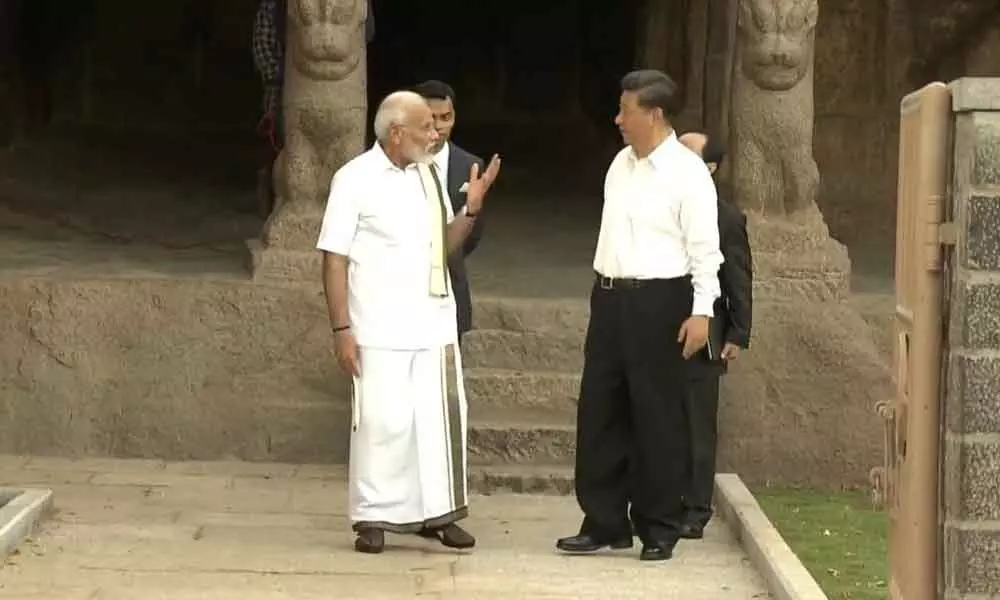Let China know it can't pull the string

Call it diplomacy or political compulsion, Prime Minister Narendra Modi, in a strategic move, held virtual all-party conference with about 20 political parties to elicit their viewpoints on the present Sino-India standoff
Call it diplomacy or political compulsion, Prime Minister Narendra Modi, in a strategic move, held virtual all-party conference with about 20 political parties to elicit their viewpoints on the present Sino-India standoff.
Naturally in such times, the entire nation would always be behind the Prime Minister and India is known to stand like a rock behind the government in times of such crises. But it is time India and all leaders seriously thought on the fundamental question: Should we trust the Chinese anymore?
We have seen many aggressions by the Dragon. Way back in 1962, when the then Prime Minister Pt Jawaharlal Nehru gave the slogan of "Hindi Chini Bhai Bhai," the People's Liberation Army invaded India in Ladakh, and across the McMahon Line in the North East Frontier Agency.
The confidence of Indian leadership that war would not begin was shattered and we were caught napping. Chinese had cut telephone lines, and Chinese infantry launched attack from rear. Indian troops had no option but to escape to Bhutan.
Many more incidents had taken place during this and finally China succeeded in achieving its objective of taking control of borders in its western sector.
Later in 1967, clashes took place between India and China in Nathu La. In this aggression, India lost about 80 soldiers while the Chinese suffered loss of over 300 soldiers. China continues to claim that Arunachal Pradesh is part of southern Tibet.
After 1967, the Galwan Valley incident is the biggest confrontation between the two armies. A close look at these developments makes it clear that China which had gone aggressive in intruding into the Indian market and dumped all its goods including kites and manja and made India almost dependent on them for cheap goods but it does not want India to ramp up infrastructure along the line of Line of Actual Control.
At a time when it was felt that the economic cooperation between China and India would result in reduction of aggression across the borders and that the series of meetings the Prime Minister Narendra Modi had with Chinese President Xi Jinping in Mahabalipuram in October last year where people from all walks of life, including young students, lined the streets waving Chinese and Indian national flags, with young men and women in Indian traditional costumes singing and dancing welcomed the Chinese president for his visit and Modi too was seen in traditional Tamil lungi, China proved that it cannot be taken by its face value and it is not trustworthy.
Even when the Galwan Valley aggression took place, it said no Indian soldier was in its custody. Chinese Foreign Ministry spokesman Zhao Lijian came a day after the Indian Army said that all Indian soldiers involved in the clashes with the Chinese army at the Galwan Valley in eastern Ladakh on Monday night have been accounted for.
"As far as I know, China presently has not detained any Indian personnel," But now reports say that 10 Indian soldiers were released on Thursday night. This again raises the question: Can the Dragon be trusted?
India's Foreign Secretary Nirupama Rao has rightly said, "This is a turning point — a very serious juncture in the relationship. With what happened in Galwan Valley, — and so much blood being shed — it can't be business as usual."
"It's time India takes a firm decision since the BJP claims that China by now understands that India is under the leadership of a new guard who understands its strategic designs in the region and the world."
Kneejerk reactions like cancelling pending public works contracts with Chinese groups or India threatening to boycott Chinese products will not help. The first question India needs to ponder is the impact of banning Chinese products on Indian economy.
India imports mainly toys, lightings, electronics products, parts of computers, cars and motorcycles, milk products, fertilizers, antibiotics, and mobiles, agricultural products, cotton textiles, handicrafts products, raw lead, iron ore, steel, copper, telecom content, and other capital goods, etc. India exports 36% of its diamonds to China.
The basic reason for the popularity of Chinese products in India is the low price of products. It sounds music to ears when it is said that ban on Chinese products will give impetus to Indian industry. But what is important is to make the dream a reality, the Government of India should ensure that the production cost of goods manufactured here is not high. The biggest problem India faces is the high cost of raw material and old technique of production, higher fixed cost etc.
India is not able to compete with China even in toy manufacturing in terms of cost. About 80% of the toy market is captured by Chinese and Italian companies. According to ASSOCHAM, about 40% of toy manufacturers had to exit from the market and some more are on the verge of closure. China also established firm grip in the Indian smartphone market.
The fact remains that even if India is ready to meet all these consequences, it cannot ban complete trade with China since the World Trade Organisation rules say that full ban on imports from any country cannot be imposed even if there are no diplomatic or trade relations with that country.
What can India do now? We should understand that any measure we may take will not affect China's economy much because China sends only two percent of its exports to India while India sends eight percent of its exports. At the most, we can impose dumping duty on electronic goods and toys.
The question now arises, can Indian manufacturers keep the price low? The people of lower income groups so far have been preferring Chinese toys since they are available at cheaper rates.
As a temporary measure following the Dragon's aggression, the Confederation of All India Traders (CAIT) has announced ban on a list of 450 categories of products made in China. These products include cosmetics, bags, toys, furniture, footwear, watches etc.
But what is more important is, as former Prime Minister H D Deve Gowda said, there is a need for toning down "nationalist rhetoric." AICC president Sonia Gandhi said, "Nation needs assurance that status quo ante is restored, and China will revert to original position."
Simultaneously, India should prepare to come out of dependence on China which of course cannot be done overnight and needs long term strategy. The Union government should work in this direction that sooner than later we can drastically cut down imports from China.
The Dragon will remain a Dragon for ever. All leaders should realise this and rework their strategies and come with timebound action plan to make China realise that it cannot dictate terms to India economically or otherwise.















